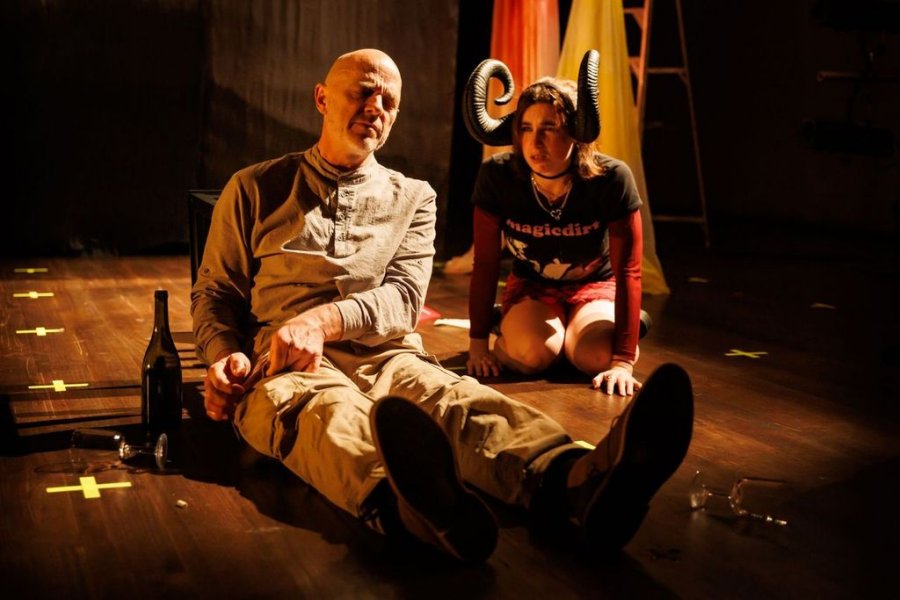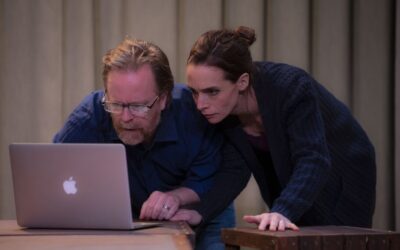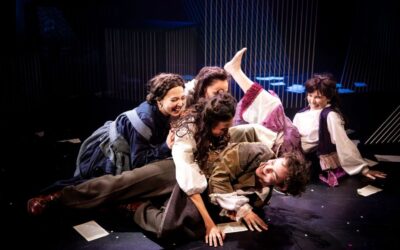By Natalie Ristovski
CW: This review contains descriptions and discussion of sexual assault and grooming.
It is rare in this country to see theatrical works that sidestep the mainstream. Gone are the days when La Fura Dels Baus or Jan Fabre could sneak their way into a festival to shock and awe audiences for a few days before the pearl-clutchers had them run off the stage. Confronting theatre is not for everyone, and damned if the conservatives don’t love to try and deny us the opportunity to delve into the depths of darkness at any chance they get. As a result, there is a certain type of grand guignolesque artistic fare that is all too few and far between in Australia – unless of course one wants to flag a ferry and head to Dark Mofo.
Thus, it was with a certain kind of nostalgic trepidation that I ventured out into the cold city afternoon to sample Bridget Mackey’s newest theatrical offering, The Exact Dimensions of Hell, at Fortyfivedownstairs.
The play centres on two main characters – The Girl (played by Matilda Gibbs) and The Witch (Daniel Schlusser) – engaged in a sequence of events that is best described as ‘a paedophile’s playbook.’
As a blow-by-blow depiction of a predator at work, the show is flawless. Schlusser is gripping as Gr8Beast (The Witch), a simpering and pathetic creature who idolises Aleister Crowley and thinks dying of cancer is a great excuse for bending underage girls to his whims. Every sickening step of the character’s dance is beautifully captured – the faux feminism, the intellectual masturbation of the ego, the push and pull of the child vs. adult narrative. Schlusser throws himself into the text with abandon, embracing the subtlety required in both delivery of lines and execution of movement as the Witch plies the Girl with alcohol and pretends to be able to teach her more about witchcraft than what Fiona Horne’s articles in Woman’s Day would afford her.
Matilda Gibbs as Lun4C4t (The Girl) is initially less convincing and seems somewhat uncomfortable in her 14-year-old guise. Her movements and line delivery fluctuate between stilted and melodramatic, and it is difficult to separate the very much adult actor from the supposed child she is portraying. It isn’t until the second half of the piece that Gibbs falls into her element and steals the show – clearly more comfortable in the realm of high drama and with the depiction of trauma. In this, she excels and far surpasses her fellow performer, and was extremely enjoyable to watch.
The stage, dressed to abstract perfection with design by Meg Wilson, is simplistic yet effective – bare floors and walls are flanked by various drapes of silk, illuminated by just the right amount of red and amber mood lighting. A solitary chair and a ladder are the only other prominent set pieces, and the starkness of the set compliments the overall spectacle.
Soundscaping by Sidney Millar is divine – the perfect blend of ethereal surrealism and ritualistic, pulsing rhythms that are equal parts hypnotic and unsettling. After a descent down what feels like a hundred stairs into the cool and dark theatre room, the auditory atmosphere is a delight. We may as well be descending to Hell.
Which, in a way, we are. And this is where my praise ends.
It is perhaps a sign of the times that one need only read the words ‘we meet a fourteen-year-old girl who wants to be a witch, and an older man who claims he can teach her how’ to know how the situation is going to unfold. It doesn’t take a content warning to alert one to the blinding light of the oncoming train wreck – post #metoo movement, we already know.
Which is perhaps the greatest flaw with this piece. For all its artistry and abstract faffery, the tale as old as time is already well-worn before it begins.
The program notes do a decent job of trying to convince those who bother to look that great care has been taken to honour the Girl’s perspective and story throughout the creation and performance of the play – an intimacy coordinator was employed to protect the players, a brief content warning is provided via the ticketing website (along with obligatory links to relevant support hotlines), though the same warnings are notably absent both in the theatre and the program notes themselves. Such assurances are unfortunately hollow in the face of what ultimately amounts to trauma porn wrapped in silk fabric with a sprinkling of spiritual symbolism.
The show suffers from an acute case of not really knowing what it wants to say and taking an awfully long time to say not much at all. The initial impact of the character’s meeting and the Girl’s seduction (read: grooming) is so viscerally repulsive as to be mesmerising – so much so that when the work dissolves into unnecessary and self-indulgent abstract surrealism, the thread of the trauma is lost.
The subsequent rape of the Girl (after a good old-fashioned bout of BDSM without a safe word) is sensitively handled and tastefully portrayed – but by then it’s really a moot point. Too often, artists make the mistake of pulling their punches with what they perceive to be the most upsetting parts of this kind of tale (that is, the actual act of penetration), failing to recognise the plethora of undiluted horror they have already heaped upon their audience. Ask any victim of childhood grooming and sexual assault – the first touch of a hand on one’s shoulder, the brush of fingertips just shy of a breast, the words “I was speaking to you as if you were an adult” are just as confronting and dare I say it, triggering, as a pair of actors pantomiming an obviously choreographed sexual act onstage.
The play’s ultimate goal, according to the program notes, is to explain to the audience why the ‘terrible thing’ that happens to The Girl (that we are to bear witness to but cannot protect her from) is not her fault. This conjures up an image of a Boomer crashing into a room of high school children declaring “UNDERAGE GIRLS ARE VICTIMS WHEN OLD MEN MANIPULATE THEM INTO SEXUAL RELATIONSHIPS.”
We know. WE KNOW.
Everyone knows.
Unfortunately, in framing this tale as an exploration of the Girl’s desires, the abuser is once again protected – and words like rape and paedophile are left out of the narrative. There is no new perspective here that one could not have gotten rewatching Lolita or Thirteen.
Perhaps a show like this would have landed better and been more topical in the mid 2010s, prior to or just before waves of women the world over posted the tiny words me and too onto their social media walls, prior to the arrests of the Weinstein’s and the Cosby’s of the world.
In 2024, it simply feels disingenuous.
There is a lot of potential in this play for something far greater than what it currently offers – the team behind it is talented and strong, and there is a dire need for more of this type of theatrical art. But until we can collectively agree to move past recycling trauma through a million different lenses, and into a stronger and more progressive narrative that tells tales of survivors over victims, we will all be stuck in the same artistic circle-jerk, masturbating our intellects over the tales of 14-year-old girls and what we think we know about their stories and desires.
Those girls deserve better.
Image: Darren Gill





